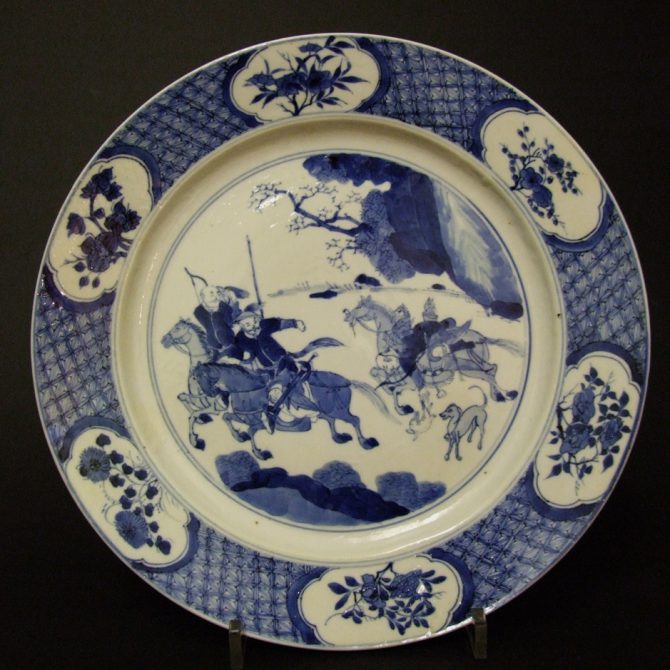
KANGXI 1662 – 1722 Chinese Export Porcelain
A Fine and Unusual Kangxi Blue and White Porcelain Dish Depicting a Mounted Hunt c.1690 – 1710. Two Huntsmen Gallop Ahead, While the Third, Also at Speed, Picks Up a Rabbit Which is Next to a Rather Startled Hound. The Border of Six Oval Cartouches of flowers set Against a Diaper Background.
SOLD
- Condition
- Small glaze chips to the back repaired.
- Size
- Diameter : 27 cm (10 1/2 inches).
- Provenance
- S.Marchant & Son, London W8 (worn label to base).
- Stock number
- 21913
Information
Chinese Hunting Subjects :
A very familiar subject on Chinese export porcelain of the late 17th and early 18th centuries is that of mounted hunting by Chinese hunts men and women. These designs were produced in blue and white, Famille Verte as well as Rouge de Fer. The scenes show well dressed people chasing their prey at speed on horseback, often using bow and arrow, to hunt for their quarry of rabbit or deer. Sometimes the huntsmen are depicted with hawks, and with dogs, which are often shown with collars. Later in the 18th century European hunting scenes were popular, but earlier Chinese hunters were depicted in Chinese settings, more specifically Manchu Chinese hunters. New rulers of China formed the Qing dynasty in the mid 17th century, they were of Manchu origin and one of the important cultural changes they made was to introduce their love of hunting, especially hunting on horseback. This love was not shared by the indigenous Han Chinese of the Ming dynasty, but it was deeply embedded in the Manchu mentality. During the first half of Qing Dynasty, the emperor would hold an Autumn hunt at Mulan. Mulan was located in Weichang, Manchu and Mongolian Autonomous County of Chengde City, Hebei Province. It was an imperial hunting lodge built on rare natural grassland coving an area of 2,324 square kilometres. Constructed in the 20th year of Emperor Kangxi`s reign (1681), the three emperors of Kangxi, Qianlong and Jiaqing all held hunting activity here in the mountains during what became an annual event for the imperial household. Hunting and the military manoeuvres were inextricably linked and both were used to try to enhance conciliation between the rather fractured ethnic minorities that constituted early Qing China.